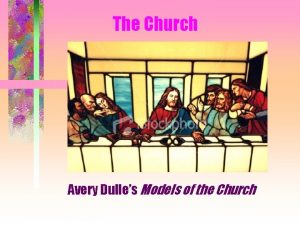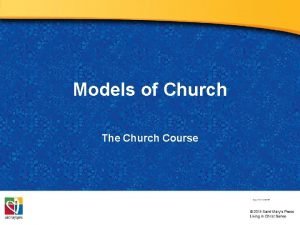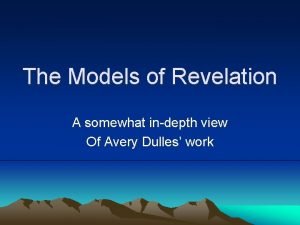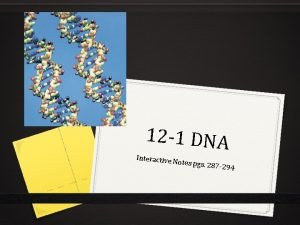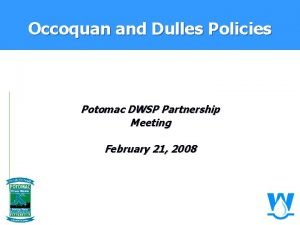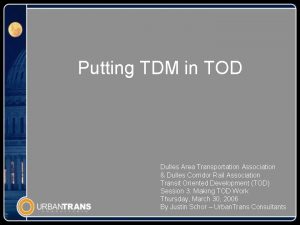The Church Avery Dulles Models of the Church













- Slides: 13

The Church Avery Dulle’s Models of the Church

First, an old definition Robert Bellarmine: “The one and true Church is the community of men brought together by profession of the same Christian faith and conjoined in the communion of the same sacraments, under the government of the legitimate pastors and especially the one vicar of Christ on earth, the Roman pontiff. ”

What does this definition imply? • Exclusionary – “profession of faith” rules out pagans, Muslims, Jews, heretics – “participation in the sacraments” rules out catechumens and excommunicants – “under the government of pastors” rules out schismatics (e. g. , Protestants) • Institutional emphasis. . . Why?

Let’s look at it again. . . “The one and true Church is the community of men brought together by profession of the same Christian faith and conjoined in the communion of the same sacraments, under the government of the legitimate pastors and especially the one vicar of Christ on earth, the Roman pontiff. ”

Dulle’s five original models • Institution • Mystical communion – community of the Spirit • Sacrament • Herald – assembly of believers • Servant – community of liberation

Dulles later adds a sixth model Community of disciples • “Discipleship is the common factor uniting all Christians with one another, for no one of them is anything but a follower and a learner in relation to Jesus Christ. ” • Dulles thinks this model embraces and corrects the other five.

Church as Institution • Focus on: – Structure – Laws – Government – Leadership • Purpose: – Preserve and teach true doctrine – Dispense grace – Maintain order

Church as Mystical Communion • Emphasis: community of believers united with God and one another in the Spirit. • Purpose: seeks to engage our hearts and stresses the importance of openness to new insights.

Church as Sacrament • Focus: church is “an outward and visible sign” of God at work in the world. • Purpose: To know who God is by Jesus’ entrance into history; so the church (imperfectly) shows us what Jesus is like; Jesus most fully known in history • Model is blend of institution and mystical communion models

Church as Herald • Focus: all those who have heard and accepted the gospel; mission of church is to believe and proclaim this saving Word • Purpose: Mission, and church points away from its structure and life, except as they affect mission • Each local church is a complete church, connected to all others only by mission

Church as Servant • Focus: community placed in the world to respond to the practical problems and needs of those most neglected (hunger, illness, poverty, violence) – Life and teachings of Jesus, esp. Matthew, Mark, and Luke – Connection with Jesus and others as they work together to help others • Mission: to pour itself out as God’s love, not to draw others into itself

Church as Community of Disciples • Focus: community of people committed to following Jesus together –Embrace different values together –Commitment to a different way of living –Balance worship, rituals, fellowship with active mission • Mission: involves both a caring response to human suffering and the act of inviting others to place their trust in Jesus and his way of living.

Discipleship model: • Biblical basis: Acts 6: 2, use of “disciples” to mean the church • Rooted in Jesus’s own discipleship – John 5: 19 -20, Matthew 11: 27 • Fits with contemporary experience: hearing and responding to a call – not just accepting doctrines but following Jesus in all situations – there would be no sacraments, New Testament, etc. without community of disciples • Power should be vested only in mature and faithful disciples
 The models of the church
The models of the church 3 models of the church
3 models of the church Models of revelation
Models of revelation How does avery’s adoptive mother describe who avery is?
How does avery’s adoptive mother describe who avery is? Nato def apush
Nato def apush Washington flyer taxi
Washington flyer taxi Difference between models and semi modals
Difference between models and semi modals Avery's experiment
Avery's experiment Polybase limitations
Polybase limitations Avery paxton
Avery paxton West bengal financial corporation v. gluco series
West bengal financial corporation v. gluco series Avery cheng
Avery cheng Avery george
Avery george Avery v bowden
Avery v bowden
